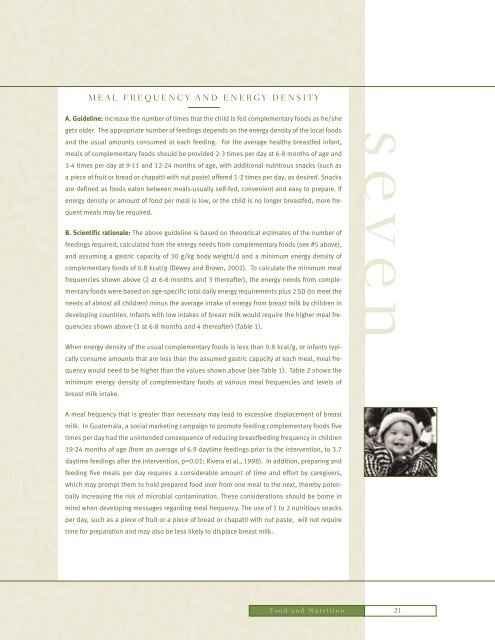Guiding Principles for Complementary Feeding of the Breastfed
Guiding Principles for Complementary Feeding of the Breastfed
Guiding Principles for Complementary Feeding of the Breastfed
You also want an ePaper? Increase the reach of your titles
YUMPU automatically turns print PDFs into web optimized ePapers that Google loves.
MEAL FREQUENCY AND ENERGY DENSITY<br />
A. Guideline: Increase <strong>the</strong> number <strong>of</strong> times that <strong>the</strong> child is fed complementary foods as he/she<br />
gets older. The appropriate number <strong>of</strong> feedings depends on <strong>the</strong> energy density <strong>of</strong> <strong>the</strong> local foods<br />
and <strong>the</strong> usual amounts consumed at each feeding. For <strong>the</strong> average healthy breastfed infant,<br />
meals <strong>of</strong> complementary foods should be provided 2-3 times per day at 6-8 months <strong>of</strong> age and<br />
3-4 times per day at 9-11 and 12-24 months <strong>of</strong> age, with additional nutritious snacks (such as<br />
a piece <strong>of</strong> fruit or bread or chapatti with nut paste) <strong>of</strong>fered 1-2 times per day, as desired. Snacks<br />
are defined as foods eaten between meals-usually self-fed, convenient and easy to prepare. If<br />
energy density or amount <strong>of</strong> food per meal is low, or <strong>the</strong> child is no longer breastfed, more frequent<br />
meals may be required.<br />
B. Scientific rationale: The above guideline is based on <strong>the</strong>oretical estimates <strong>of</strong> <strong>the</strong> number <strong>of</strong><br />
feedings required, calculated from <strong>the</strong> energy needs from complementary foods (see #5 above),<br />
and assuming a gastric capacity <strong>of</strong> 30 g/kg body weight/d and a minimum energy density <strong>of</strong><br />
complementary foods <strong>of</strong> 0.8 kcal/g (Dewey and Brown, 2002). To calculate <strong>the</strong> minimum meal<br />
frequencies shown above (2 at 6-8 months and 3 <strong>the</strong>reafter), <strong>the</strong> energy needs from complementary<br />
foods were based on age-specific total daily energy requirements plus 2 SD (to meet <strong>the</strong><br />
needs <strong>of</strong> almost all children) minus <strong>the</strong> average intake <strong>of</strong> energy from breast milk by children in<br />
developing countries. Infants with low intakes <strong>of</strong> breast milk would require <strong>the</strong> higher meal frequencies<br />
shown above (3 at 6-8 months and 4 <strong>the</strong>reafter) (Table 1).<br />
When energy density <strong>of</strong> <strong>the</strong> usual complementary foods is less than 0.8 kcal/g, or infants typically<br />
consume amounts that are less than <strong>the</strong> assumed gastric capacity at each meal, meal frequency<br />
would need to be higher than <strong>the</strong> values shown above (see Table 1). Table 2 shows <strong>the</strong><br />
minimum energy density <strong>of</strong> complementary foods at various meal frequencies and levels <strong>of</strong><br />
breast milk intake.<br />
A meal frequency that is greater than necessary may lead to excessive displacement <strong>of</strong> breast<br />
milk. In Guatemala, a social marketing campaign to promote feeding complementary foods five<br />
times per day had <strong>the</strong> unintended consequence <strong>of</strong> reducing breastfeeding frequency in children<br />
19-24 months <strong>of</strong> age (from an average <strong>of</strong> 6.9 daytime feedings prior to <strong>the</strong> intervention, to 3.7<br />
daytime feedings after <strong>the</strong> intervention, p=0.01; Rivera et al., 1998). In addition, preparing and<br />
feeding five meals per day requires a considerable amount <strong>of</strong> time and ef<strong>for</strong>t by caregivers,<br />
which may prompt <strong>the</strong>m to hold prepared food over from one meal to <strong>the</strong> next, <strong>the</strong>reby potentially<br />
increasing <strong>the</strong> risk <strong>of</strong> microbial contamination. These considerations should be borne in<br />
mind when developing messages regarding meal frequency. The use <strong>of</strong> 1 to 2 nutritious snacks<br />
per day, such as a piece <strong>of</strong> fruit or a piece <strong>of</strong> bread or chapatti with nut paste, will not require<br />
time <strong>for</strong> preparation and may also be less likely to displace breast milk.<br />
Food and Nutrition<br />
seven 21

















